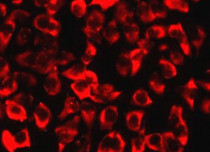ARG58360
anti-RPS3 antibody
anti-RPS3 antibody for ICC/IF,Western blot and Human,Mouse,Rat
Overview
| Product Description | Rabbit Polyclonal antibody recognizes RPS3 |
|---|---|
| Tested Reactivity | Hu, Ms, Rat |
| Tested Application | ICC/IF, WB |
| Host | Rabbit |
| Clonality | Polyclonal |
| Isotype | IgG |
| Target Name | RPS3 |
| Antigen Species | Human |
| Immunogen | Recombinant fusion protein corresponding to aa. 1-243 of Human RPS3 (NP_000996.2). |
| Conjugation | Un-conjugated |
| Alternate Names | S3; EC 4.2.99.18; 40S ribosomal protein S3 |
Application Instructions
| Application Suggestion |
|
||||||
|---|---|---|---|---|---|---|---|
| Application Note | * The dilutions indicate recommended starting dilutions and the optimal dilutions or concentrations should be determined by the scientist. | ||||||
| Positive Control | HT-29 | ||||||
| Observed Size | 30 kDa |
Properties
| Form | Liquid |
|---|---|
| Purification | Affinity purified. |
| Buffer | PBS (pH 7.3), 0.02% Sodium azide and 50% Glycerol. |
| Preservative | 0.02% Sodium azide |
| Stabilizer | 50% Glycerol |
| Storage Instruction | For continuous use, store undiluted antibody at 2-8°C for up to a week. For long-term storage, aliquot and store at -20°C. Storage in frost free freezers is not recommended. Avoid repeated freeze/thaw cycles. Suggest spin the vial prior to opening. The antibody solution should be gently mixed before use. |
| Note | For laboratory research only, not for drug, diagnostic or other use. |
Bioinformation
| Database Links | |
|---|---|
| Gene Symbol | RPS3 |
| Gene Full Name | ribosomal protein S3 |
| Background | Ribosomes, the organelles that catalyze protein synthesis, consist of a small 40S subunit and a large 60S subunit. Together these subunits are composed of 4 RNA species and approximately 80 structurally distinct proteins. This gene encodes a ribosomal protein that is a component of the 40S subunit, where it forms part of the domain where translation is initiated. The protein belongs to the S3P family of ribosomal proteins. Studies of the mouse and rat proteins have demonstrated that the protein has an extraribosomal role as an endonuclease involved in the repair of UV-induced DNA damage. The protein appears to be located in both the cytoplasm and nucleus but not in the nucleolus. Higher levels of expression of this gene in colon adenocarcinomas and adenomatous polyps compared to adjacent normal colonic mucosa have been observed. This gene is co-transcribed with the small nucleolar RNA genes U15A and U15B, which are located in its first and fifth introns, respectively. As is typical for genes encoding ribosomal proteins, there are multiple processed pseudogenes of this gene dispersed through the genome. Multiple alternatively spliced transcript variants encoding different isoforms have been found for this gene. [provided by RefSeq, May 2012] |
| Function | Involved in translation as a component of the 40S small ribosomal subunit. Has endonuclease activity and plays a role in repair of damaged DNA. Cleaves phosphodiester bonds of DNAs containing altered bases with broad specificity and cleaves supercoiled DNA more efficiently than relaxed DNA. Displays high binding affinity for 7,8-dihydro-8-oxoguanine (8-oxoG), a common DNA lesion caused by reactive oxygen species (ROS). Has also been shown to bind with similar affinity to intact and damaged DNA. Stimulates the N-glycosylase activity of the base excision protein OGG1. Enhances the uracil excision activity of UNG1. Also stimulates the cleavage of the phosphodiester backbone by APEX1. When located in the mitochondrion, reduces cellular ROS levels and mitochondrial DNA damage. Has also been shown to negatively regulate DNA repair in cells exposed to hydrogen peroxide. Plays a role in regulating transcription as part of the NF-kappa-B p65-p50 complex where it binds to the RELA/p65 subunit, enhances binding of the complex to DNA and promotes transcription of target genes. Represses its own translation by binding to its cognate mRNA. Binds to and protects TP53/p53 from MDM2-mediated ubiquitination. Involved in spindle formation and chromosome movement during mitosis by regulating microtubule polymerization. Involved in induction of apoptosis through its role in activation of CASP8. Induces neuronal apoptosis by interacting with the E2F1 transcription factor and acting synergistically with it to up-regulate pro-apoptotic proteins BCL2L11/BIM and HRK/Dp5. Interacts with TRADD following exposure to UV radiation and induces apoptosis by caspase-dependent JNK activation. [UniProt] |
| Cellular Localization | Cytoplasm, Mitochondrion inner membrane, Nucleus, Peripheral membrane protein, cytoskeleton, nucleolus, spindle. [UniProt] |
| Calculated MW | 27 kDa |
| PTM | Methylation by PRMT1 is required for import into the nucleolus and for ribosome assembly. Sumoylation by SUMO1 enhances protein stability through increased resistance to proteolysis. Sumoylation occurs at one or more of the three consensus sites, Lys-18, Lys-214 and Lys-230. Phosphorylation at Thr-221 by CDK1 occurs mainly in G2/M phase (PubMed:21871177). Phosphorylation by PRKCD occurs on a non-ribosomal-associated form which results in translocation of RPS3 to the nucleus and enhances its endonuclease activity (PubMed:19059439). Phosphorylated on Ser-209 by IKKB in response to activation of the NF-kappa-B p65-p50 complex which enhances the association of RPS3 with importin-alpha and mediates the nuclear translocation of RPS3 (PubMed:21399639). Phosphorylation by MAPK is required for translocation to the nucleus following exposure of cells to DNA damaging agents such as hydrogen peroxide (PubMed:17560175). Phosphorylation by PKB/AKT mediates RPS3 nuclear translocation, enhances RPS3 endonuclease activity and suppresses RPS3-induced neuronal apoptosis (PubMed:20605787). Ubiquitinated (PubMed:16314389). This is prevented by interaction with HSP90 which stabilizes the protein (PubMed:16314389). Monoubiquitinated at Lys-214 by ZNF598 when a ribosome has stalled during translation of poly(A) sequences, leading to preclude synthesis of a long poly-lysine tail and initiate the ribosome quality control (RQC) pathway to degrade the potentially detrimental aberrant nascent polypeptide (PubMed:28065601, PubMed:28132843). [UniProt] |
Images (2) Click the Picture to Zoom In







